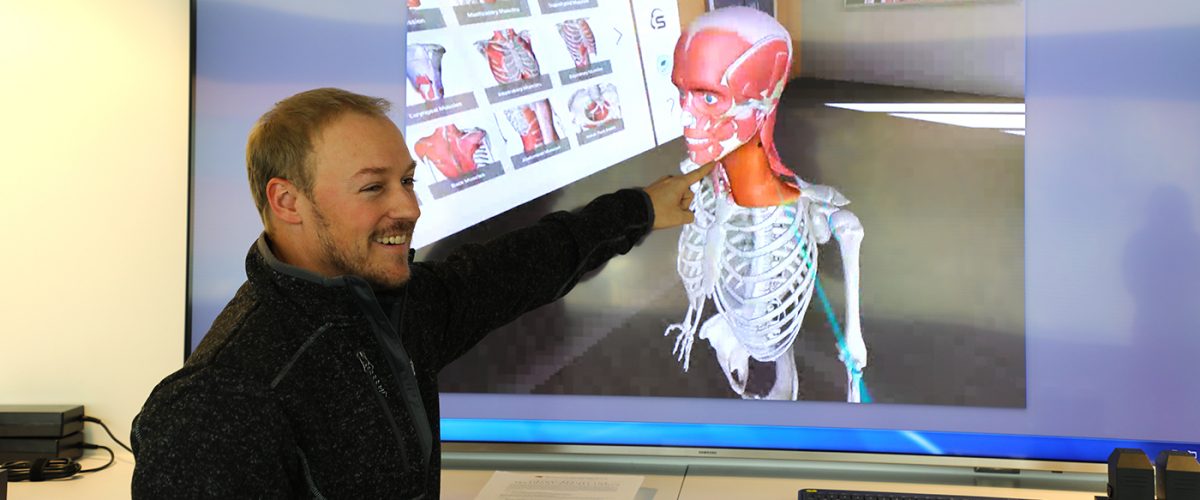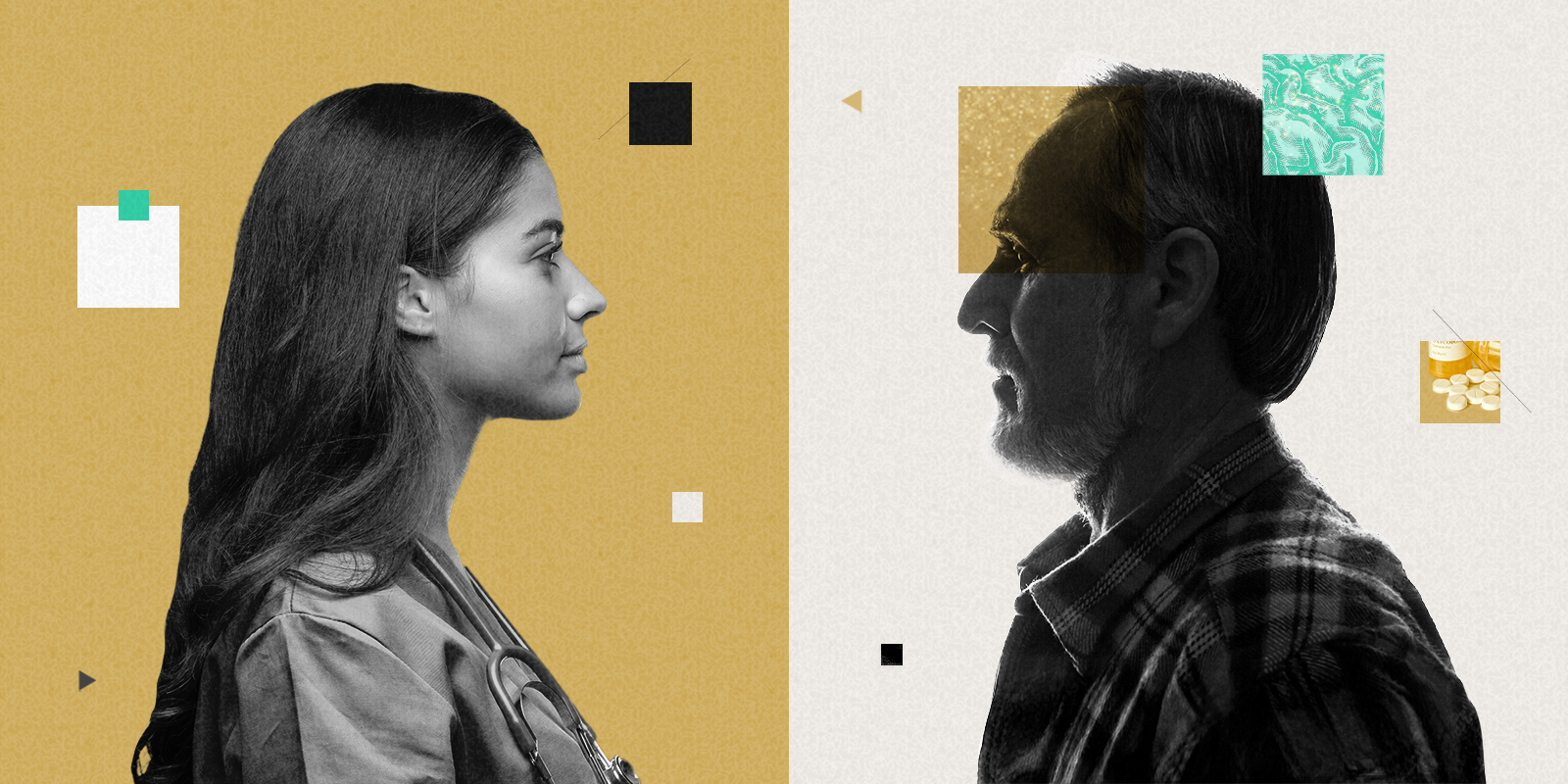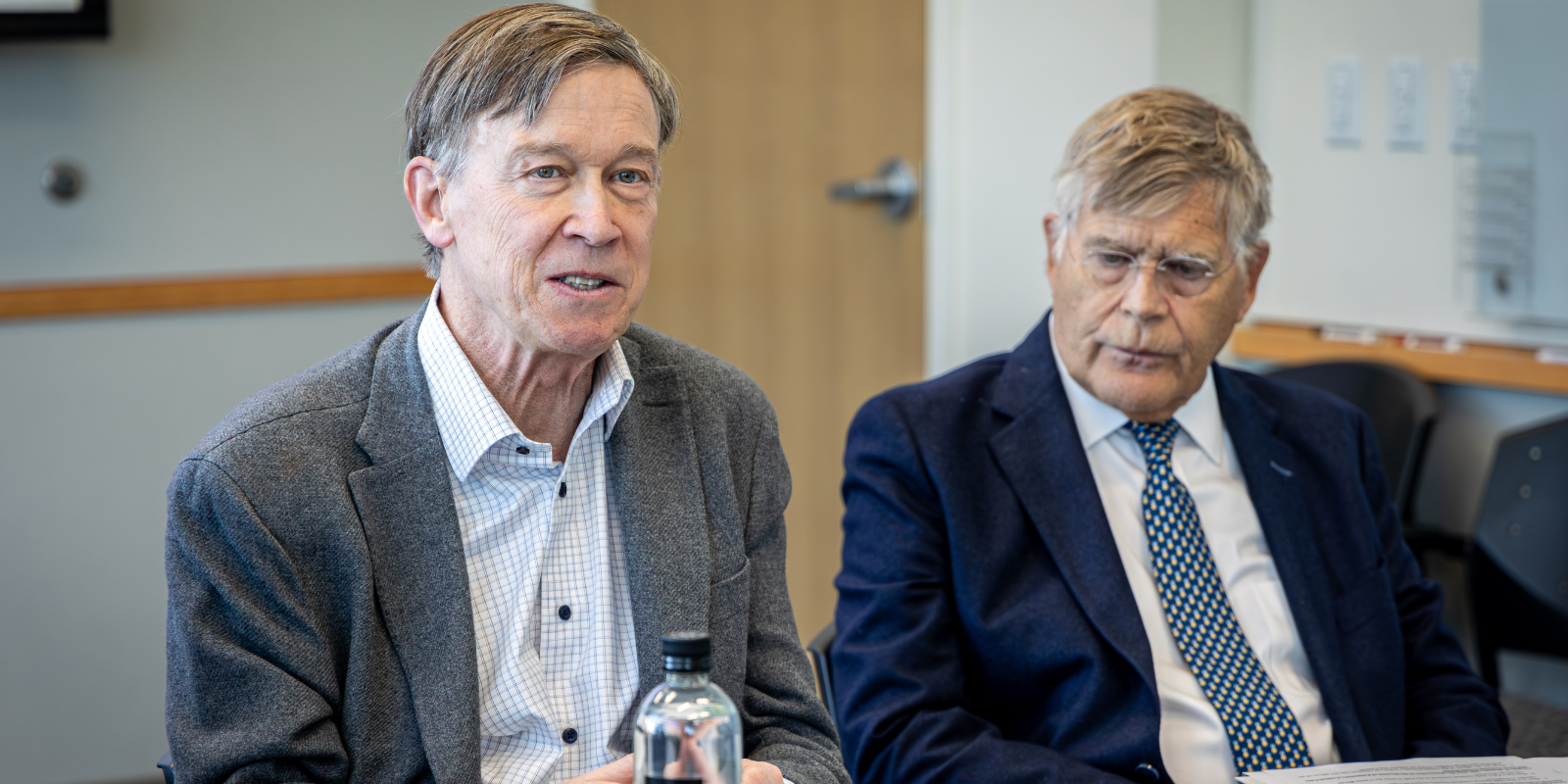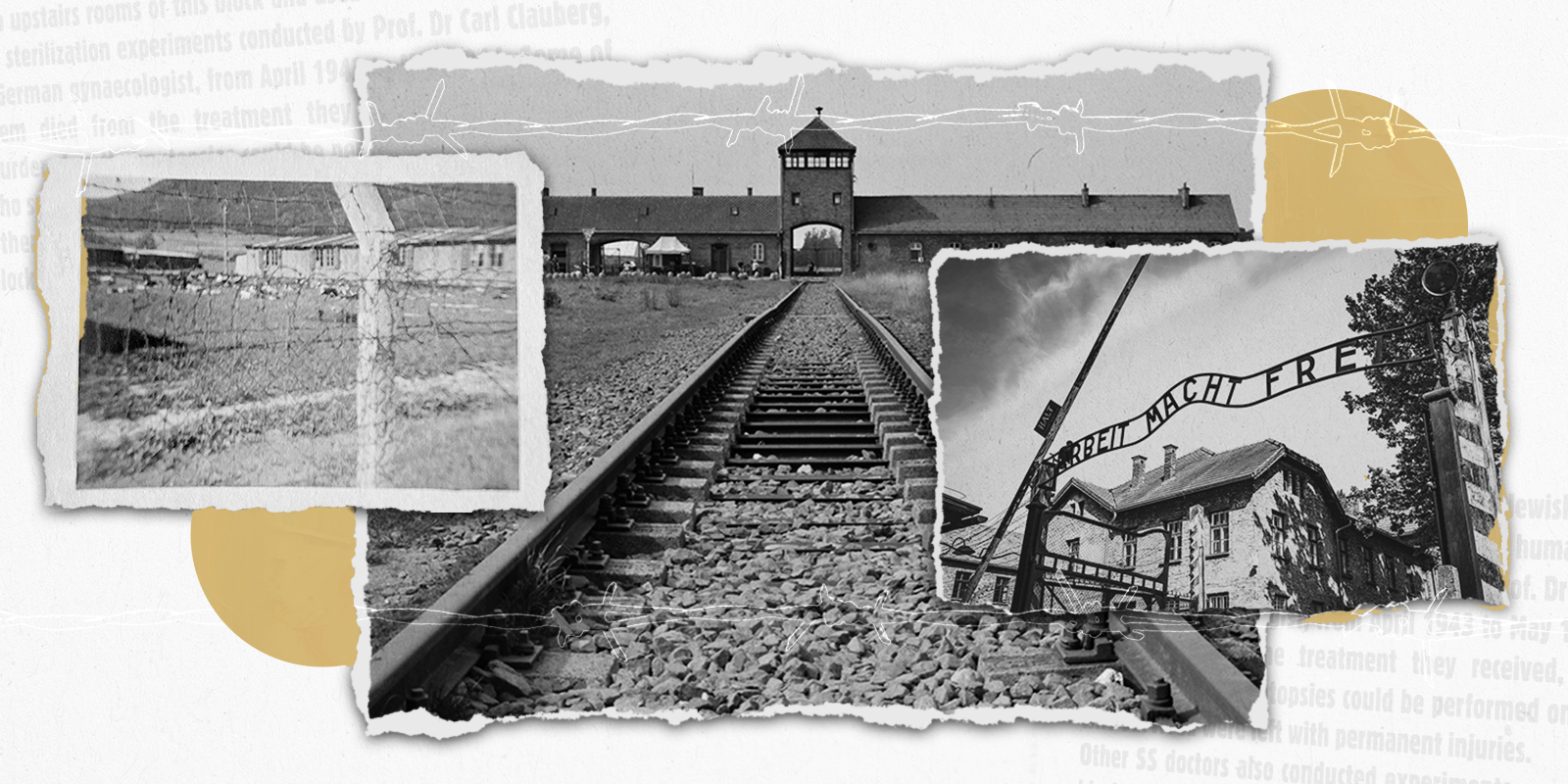In Chase Lewis’ first semester at the CU School of Dental Medicine, he dug deep into human anatomy on his school-provided iPad. He used a state-of-the-art dental trainer that simulates drilling on an actual tooth. He even explored new worlds, including a land of dinosaurs and the surface of Mars, in the new Immersive Learning Suite.
In the suite, which has 10 virtual reality headsets and backpacks available for checkout, Lewis and his classmates explored digital environments that are on the leading edge of education for future dentists. While enjoying content that’s tailored to their individual learning styles, the students are moving faster, and in a more engaged manner, into all facets of their training.
Future-ready investment
“With all the opportunities we’ve been given, students can go in any direction,” said Lewis, who already holds a master’s degree in modern human anatomy. “As a first-year dental student, to get access to those three pieces of technology, was awesome. All of the investment here is future ready. It’s great for everything we need” to become dentists.
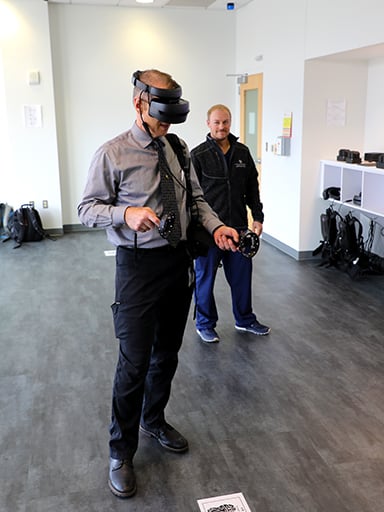
Tom Greany, DDS, assistant professor and director of academic technology initiatives, demonstrates the virtual reality anatomy program in the Immersive Learning Suite at the CU School of Dental Medicine. First-year dental student Chase Lewis looks on.
Indeed, the CU School of Dental Medicine is pioneering a multi-modal, digital approach to learning. It is one of only a handful of dental schools nationwide with Simodont dental trainers, which provide high-fidelity simulation and training. Previously, dental students first picked up hand pieces during pre-clinical lab, typically a second-semester class. Now, with the Simodont, they are assigned first-semester psycho-motor exercises with hand pieces on the VR trainer.
“It puts them farther ahead quicker than in the past,” said Michael Henry, DDS, PhD, the school’s associate dean for academic affairs. “Dentistry is a visual art; it’s based on three-dimensional relationships. So, utilization of VR technology really allows us to take advantage of that.”
Goal: Pioneers in education
At a retreat two years ago, school faculty and leadership discussed how students are best served by experiencing content through multiple modalities. The brainstorm sparked plans to further invest in both innovation and personnel to support all aspects of pre-clinical, didactic and clinical dental education.
“We have this incredible generation of people who have grown up with technology as a greater focus in their lives. So, how do we maximize that?” said Dean Denise Kassebaum, DDS, MS. “How do we make opportunities to take this very special student and develop a productive educational experience that is different from the regular dental education? Everything we do is an intentional investment. It’s designed to engage the learner and make sure we position our graduates to be future ready.”
In the Immersive Learning Suite — which, with an emphasis on basic sciences, is among the first in the nation’s dental schools — students use an app that allows them to explore in stunning detail all the systems of human anatomy. In the VR environment, they view a 3D representation of a body, then construct (or deconstruct) it with the muscular, cardiovascular, nervous, digestive and other systems of anatomy.
Between the VR anatomy and the resiliency options, the latter offering relaxing earthly or otherworldly excursions, “we have a hard time getting them out of there to go to class,” said Tom Greany, DDS, assistant professor and director of academic technology initiatives.
Better, faster training
The dental school will track and measure the effectiveness of the new tools. So far, results are encouraging. Professors are able to monitor how long, and how effectively, students are using the Haptics Advanced Technology Suite. “In the Introduction to Dentistry course we were able to track their scores when they repeated exercises multiple times,” Greany said. “Did they get better, faster, and did their efficiency improve? We were able to show some early evidence that that appears to be the case.”
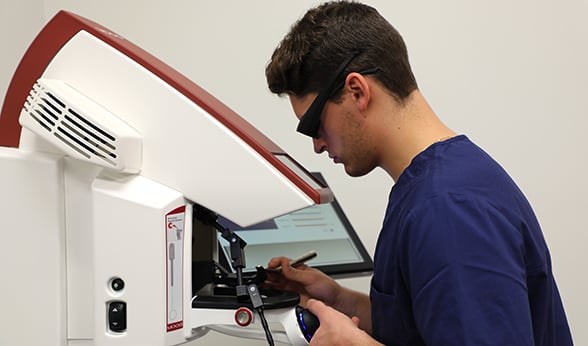
David Radeka, a dental school student, practices drilling a tooth on the Simodont trainer at the CU School of Dental Medicine.
Performing procedures with a hand mirror — called indirect vision — is typically a difficult skill for dental students to learn. “I’m looking in the mirror and I think my hand is going one way and it’s going the opposite way,” Lewis said. “So (the indirect vision training on the Simodont) is a great opportunity to learn that early on. I’m excited for it.”
Because a digital scan of a patient’s teeth can be uploaded into the Simodont, students can practice on a virtual simulation of an actual person they will treat in, for instance, a board exam.
Developing best practices
Beyond training for a high-stakes scenario like a board exam, the various technologies are paying off in many personalized-learning situations as well.
Ben Wilkoff, the school’s program manager for digital education and academic technology, was struck by the “beautiful” way a student took notes on arterial flow in the brain. The student, using his iPad, represented the arterial system as a subway map. “It’s letting them be the agents of their learning,” Wilkoff said. “They are the ones who get to determine, ‘This is what I need to enable and empower my learning.’”
The dental school is measuring outcomes with the new modalities and will explore how to best apply the new technologies, including possibly forging collaborations with other disciplines on campus.
“We want to get good at it — really, really good at it — and write some of those best practices so others can feel good about moving forward,” Wilkoff said. “We’ve had students using the VR technology and we ask, ‘What would make this better? What would make this more supportive?’ I think those are the best questions we’ve been asking.
“We are literally the only ones doing this and establishing what it looks like for other folks,” he said.
The VR immersions in resiliency, meanwhile, encourage health care providers to recharge and refresh in breathtaking virtual spaces. “There is a comprehensive set of things we all ought to consider about being a health care provider, and that starts with being healthy yourself and being able to be present and mindful for the patients you have the privilege to treat,” Kassebaum said.
Scratching the surface
The dean noted that VR environments also offer opportunities for empathy training for health care providers. For example, there are VR applications that show a user what it’s like to be colorblind.
“How can we truly teach empathy for some of the limitations that people may have? That’s part of being a health care provider and providing person-centered care,” Kassebaum said. “We’re now positioned to expand into even broader areas with these new technologies. We feel like we’re right at the edge, scratching the surface on something that has so much potential.”
Lewis, meanwhile, looks forward to the rest of his dental school experience at CU Anschutz. He loves that the commitment to the cutting-edge technology is so great that students can use it any time; there’s no waiting for access.
“It’s all right here, so go try it,” he said. “You can be as excited as you want about it. Let’s see what happens.”
